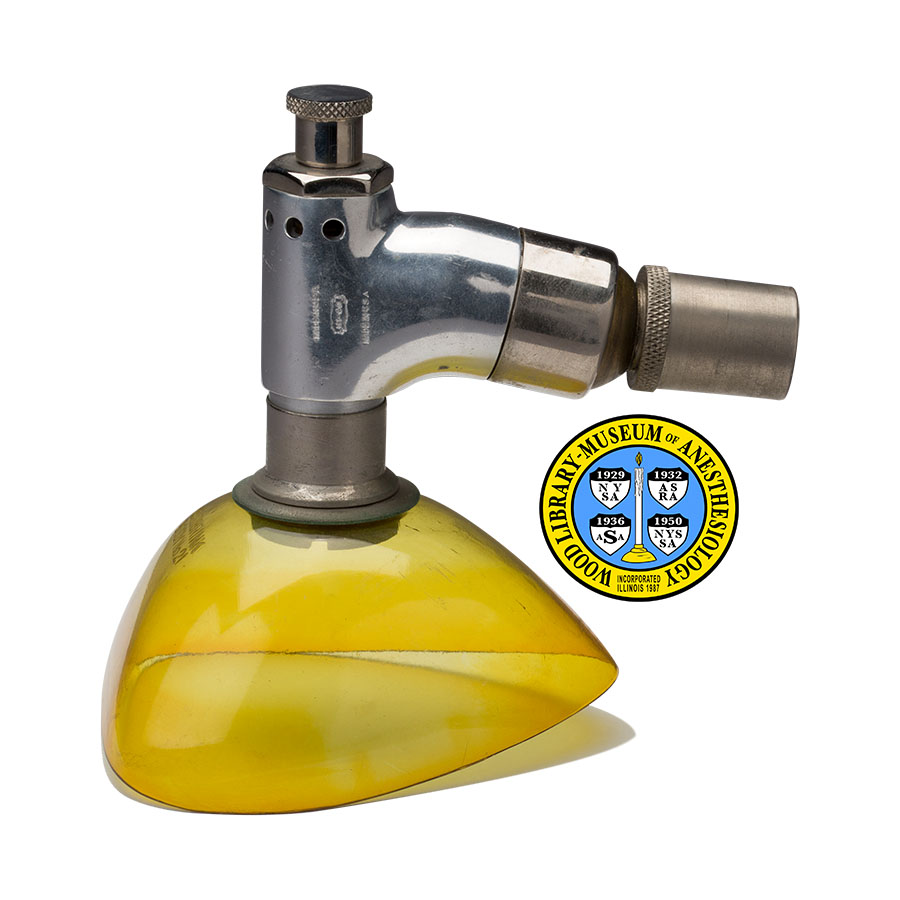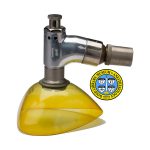Heidbrink Celluloid Mask
In the late 19th and early 20th centuries, some anesthesia masks were made of transparent materials. By using a glass or celluloid mask, the patient's breathing could be monitored without lifting the mask. Vomit, blood, secretions or objects could also be observed and removed as threats for airway obstruction or aspiration. Celluloid was the first modern plastic. Developed in the 1860s, it was used to make numerous products for over a century. The first known celluloid anesthesia mask was introduced in 1894. Celluloid masks had the advantage of being much lighter in weight than glass. However, celluloid is a highly flammable material, and has largely been replaced by other plastics.
The American dentist, inventor and manufacturer Jay Heidbrink, D.D.S. (1875-1957), patented his first anesthesia machine in 1912. Called the Heidbrink Anesthetizer, it administered a mix of nitrous oxide, oxygen and ether. It was made in several configurations and had a number of optional attachments. The buyer could select a face mask made of rubber, or one made of celluloid like the example shown here. When new, the mask would have had an inflatable rubber rim, for a closer and more comfortable fit to the patient's face. The built-in metal connector led to a hose attached to the machine. The valve on the back of this connector could be adjusted to admit a greater or lesser amount of fresh air. In the mid-1930s, the Anesthetizer was superseded by the better known Heidbrink Kinet-O-Meter machine.
Catalog Record: Heidbrink Celluloid Mask Heidbrink Celluloid Mask
Access Key: apou
Accession No.: 66-110 D
Title: [Heibrink celluloid mask].
Corporate Author: Heidbrink Company.
Title variation: Alt Title
Title: [Heidbrink Anesthetizer mask].
Publisher: Minneapolis, Minnesota : Heidbrink Company, [between ca. 1920 and 1939].
Physical Description: 1 anesthesia mask : metals, celluloid ; 13 x 9 x 13.5 cm.
Subject: Anesthesia, Inhalation – instrumentation.
Subject: Masks, Anesthesia.
Note Type: General
Notes: The first year in the date range is based on the earliest published reference to the Heidbrink Anesthetizer found by the cataloger. Earlier Heidbrink equipment did not use a mask of this type. The second year in the date range is the year in which most published sources agree that the Heidbrink Company was acquired by the Ohio Company. The excellent condition of this piece suggests a later rather than an earlier date.
The object is described from the patient’s perspective, with the open side of the mask facing downward. The part of the mask shaped to cover the patient’s nose is considered the front, and the open end of the connector is considered the back. The top is considered the knob on the valve.
The height of the object was measured with the knob turned to the top of its stem. The depth of the object was measured with the connector placed in perfect alignment with the horizontal arm of the metal component. This will vary when the ball joint is used to change the position of the connector.
Note Type: Citation
Notes: The Chemical Heritage Foundation website. https://www.chemheritage.org/distillations/magazine/celluloid-the-eternal-substitute. Accessed March 14, 2017.
Note Type: Citation
Notes: Fleming, Christopher. Simple apparatus for the inhalation of chloroform. Dublin Medical Press. 1850; 24: 292.
Note Type: Citation
Notes: Heidbrink Company File. Located at: Wood Library-Museum of Anesthesiology, Schaumburg, Illinois.
Note Type: Citation
Notes: The Plastics Historical Society website. http://plastiquarian.com/?page_id=14221. Accessed March 14, 2017.
Note Type: Citation
Notes: Silk, JFW. Celluloid Facepieces and Masks. BMJ. March 3, 1894:1(1731): 471-472.
Note Type: Citation
Notes: Slater HM, Stephen CR. Anesthesia for infants and children; nonrebreathing technique.” Archives of Surgery. February, 1951;62:251-259.
Note Type: Physical Description
Notes: One anesthesia mask; Consists of a transparent yellow mask made of celluloid, which is attached to a more-or-less T-shaped metal component; The shape of the mask is a roughly triangular dome; The bottom edge of the mask is curved, so that the front (the point of the triangle), is tilted higher than the back (the base of the triangle); There is a shallow scallop in the back edge; The mask alone measures approximately 5 x 8.75 x 9.75 centimeters;
The upright arm of the metal component is attached to the mask at its lower end, and holds a spring-loaded valve at its upper end; The mask can be turned 360 degrees around this post; A metal washer or ring interposes between the upright and the mask; On top of the upright there is a control knob that can be turned upward or downward on its stem; When the knob is turned upward, the valve admits air, and when turned to the bottom of its stem the valve excludes air; Below this, the shaft of the upright has a horizontal row of six air holes that face forward; The other arm of the metal component is not quite horizontal; Rather, it bends slightly downward toward the patient; This arm ends in a ball joint that holds a connector;
The back of the mask is embossed: “HEIDBRINK [new line] BODY No. 21”; One side of the upright arm of the metal component is stamped “MADE IN U.S.A. [new line] Hi-Co [new line] MADE IN U.S.A.”; The opposite side of the upright is stamped “12-33”; The back of the horizontal arm bears the painted accession number “66-110 D”.
Note Type: Reproduction
Notes: Photographed by Mr. Steve Donisch, November 14, 2016.
Note Type: Acquisition
Notes: Gift of the Mayo Clinic, Rochester, MN.
Note Type: Historical
Notes: In the late 19th and early 20th centuries, most of the face masks and inhalers made for the administration of anesthesia were opaque. In most masks used for the open-drop technique, cloth was stretched over a wire frame and saturated with a liquid anesthetic such as chloroform. Masks that were integral to hand-held inhalers were usually made of materials such as leather or metal. Relatively few were made of glass or celluloid. By using a transparent mask, the patient’s breathing could be monitored without interrupting the anesthetic by lifting the mask. Airway obstruction due to aspirated stomach contents could also be readily observed. The earliest known glass anesthesia mask was introduced by Christopher Fleming in 1850. The first known celluloid anesthesia mask was introduced by J. F. W. Silk in 1894. The Silk Inhaler was available in two models, either all-metal, or celluloid.
Celluloid is considered the first modern plastic. Developed in the 1860s, it was first used to make billiard balls, and has been part of numerous other products for over a century. A celluloid anesthesia mask had the advantage of being much lighter in weight than glass. But it is a highly flammable material, and has largely been replaced by other plastics. The last known anesthesia mask to be made of celluloid was introduced by Slater and Stephen in 1951.
The American dentist, inventor and manufacturer Jay Heidbrink, D.D.S. (1875-1957) patented his first anesthesia machine in 1912. Called the Heidbrink Anesthetizer, it administered a mix of nitrous oxide, oxygen and ether. It was made in a several configurations and had a number of optional attachments. The buyer could select a face mask made of rubber, or one made of celluloid. When new, the mask would have had an inflatable rubber rim, for a closer and more comfortable fit to the patient’s face. The built-in metal component led to a hose attached to the machine. A ball joint attached to the connector enabled the mask to be applied in any position; The valve on the top of this component could be adjusted to admit or exclude air by turning the knob.
Note Type: Exhibition
Notes: Selected for the WLM website.


